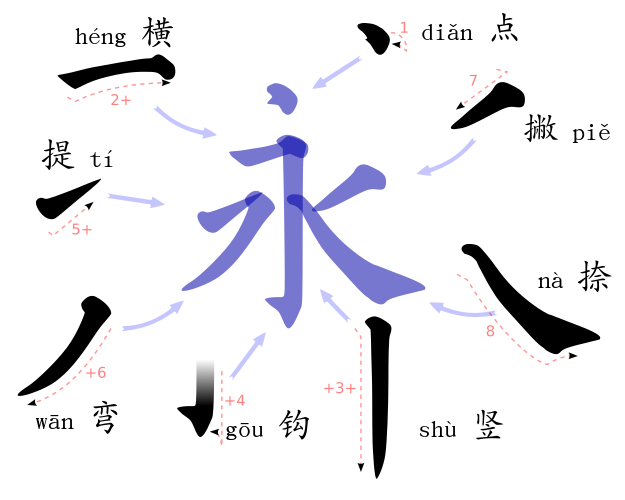File:8 strokes of 永-zh.svg

Original file (SVG file, nominally 625 × 500 pixels, file size: 48 KB)
Captions
Captions
Summary[edit]
| Description8 strokes of 永-zh.svg |
The Chinese character 永 (yǒng), meaning “forever” or “permanence”, is often used to illustrate the 8 basic principles used to draw strokes that compose ideographic characters.
|
| Date | |
| Source | |
| Author |
|
Original upload log[edit]
This image is a derivative work of the following images:
- 8 strokes of 永.png licensed with Cc-by-sa-2.0
- 2008-09-26T14:07:45Z Sarang 625x500 (49601 Bytes) {{Information |Description=strokes numbered |Source=8 strokes of 永.png |Date=~~~~~ |Author=~~~ |Permission= |other_versions= }}
- 2007-05-31T17:33:40Z Yug 625x500 (40528 Bytes) new version with red-directional arrow.
- 2006-05-09T18:02:41Z Yug 625x500 (34290 Bytes) Own work using Inkscape.
Uploaded with derivativeFX
Licensing[edit]
- You are free:
- to share – to copy, distribute and transmit the work
- to remix – to adapt the work
- Under the following conditions:
- attribution – You must give appropriate credit, provide a link to the license, and indicate if changes were made. You may do so in any reasonable manner, but not in any way that suggests the licensor endorses you or your use.
File history
Click on a date/time to view the file as it appeared at that time.
| Date/Time | Thumbnail | Dimensions | User | Comment | |
|---|---|---|---|---|---|
| current | 18:29, 15 June 2020 |  | 625 × 500 (48 KB) | Cangjie6 (talk | contribs) | Reverted to version as of 14:01, 22 December 2012 (UTC) |
| 15:24, 27 January 2020 |  | 625 × 500 (58 KB) | Vavilexxx (talk | contribs) | Reverted to version as of 22:52, 12 February 2010 (UTC) | |
| 14:01, 22 December 2012 |  | 625 × 500 (48 KB) | H2NCH2COOH (talk | contribs) | 横 hēng → héng | |
| 04:46, 16 February 2010 |  | 625 × 500 (48 KB) | Yug (talk | contribs) | avoid red en:Chartjunk | |
| 22:52, 12 February 2010 |  | 625 × 500 (58 KB) | Rhynyx (talk | contribs) | {{Information |Description={{created with Inkscape}} Vector version of Image:8_strokes_of_永.png Visualisation of the 8 strokes in writing hanzi, kanji, kana, hantu, & hanja characters. The orders of each stroke used to write the above characte |
You cannot overwrite this file.
File usage on Commons
The following 7 pages use this file:
File usage on other wikis
The following other wikis use this file:
- Usage on be.wikipedia.org
- Usage on de.wikipedia.org
- Usage on en.wikipedia.org
- Usage on en.wikibooks.org
- Usage on en.wiktionary.org
- Usage on fr.wikipedia.org
- Usage on fr.wiktionary.org
- Usage on hi.wikipedia.org
- Usage on hu.wikipedia.org
- Usage on id.wikipedia.org
- Usage on ja.wikipedia.org
- Usage on ms.wikipedia.org
- Usage on my.wikipedia.org
- Usage on nl.wikipedia.org
- Usage on pt.wikipedia.org
- Usage on ru.wikipedia.org
- Usage on uk.wikipedia.org
- Usage on www.wikidata.org
- Usage on zh-yue.wikipedia.org
- Usage on zh.wikipedia.org
Metadata
This file contains additional information such as Exif metadata which may have been added by the digital camera, scanner, or software program used to create or digitize it. If the file has been modified from its original state, some details such as the timestamp may not fully reflect those of the original file. The timestamp is only as accurate as the clock in the camera, and it may be completely wrong.
| Width | 500pt |
|---|---|
| Height | 400pt |